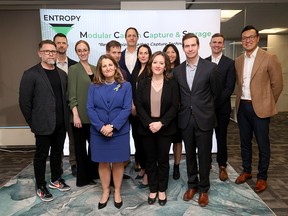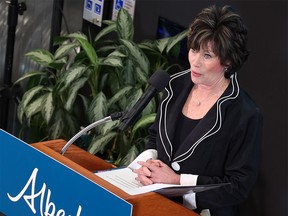
The report delves into the complex, but essential, world of Alberta’s heavy emitters program and Alberta’s industrial carbon price

Article content
The Alberta government has ambitious plans to attract tens of billions of dollars of investment into decarbonization projects, such as carbon capture and hydrogen developments.
However, the province risks missing out if its heavy industrial emitters program — known as the Technology Innovation and Emissions Reduction (TIER) framework — is swamped by excessive carbon credits hitting the market, undercutting the economics of new developments, warns a new study.
Advertisement 2
Article content
A report to be released Tuesday by Clean Prosperity, a Canadian climate policy organization, says the Alberta government should adopt several recommendations to prevent that from happening.
It suggests increasing and adapting the stringency standards under TIER that large emitters have to meet, and that the provincial government participate in a program to backstop the long-term value of carbon credits and offsets — such as providing carbon contracts for difference.
“If changes to the TIER program aren’t made, the carbon market in Alberta is likely to face an oversupply of carbon credits before the end of the decade,” report co-author Emma Dizon, Clean Prosperity’s program manager for Western Canada, said in an interview.
“And this matters, because it will dampen the province’s ability to attract those low-carbon industries and projects like CCUS that are so important to the economy and to our emissions-reduction efforts.”
The report delves into the complex, but essential, world of Alberta’s heavy emitters program and Alberta’s industrial carbon price.
Article content
Advertisement 3
Article content
Almost 600 regulated facilities currently participate in TIER. Under the framework, operations such as oilsands complexes and other large industrial facilities must meet an emissions intensity benchmark, which grows more stringent each year.
Alberta agreed in 2022 to tighten its annual benchmark by two per cent annually — up from one per cent previously — while oilsands facilities will face a four per cent tightening starting in 2029.
If companies beat the benchmark or take steps to displace emissions — such as by developing carbon capture utilization and storage (CCUS) projects — they can earn credits.
If companies exceed their benchmark, they must either pay into the fund at the set carbon price — currently $80 per tonne of CO2 — or go into the market and buy offsets to meet their obligation, giving these credits a value.
The provincial and federal governments have both adopted a net-zero by 2050 target, and many companies are actively considering investing billions of dollars into projects to lower their own emissions.
A handful have already done so.
Recommended from Editorial
Advertisement 4
Article content
Other initiatives are under consideration, such as the Pathways Alliance’s $16.5-billion carbon capture network that would eventually connect more than a dozen oilsands facilities to an underground storage hub near Cold Lake.
In most cases, carbon capture and storage projects don’t generate additional revenue, other than through creating carbon credits that can be used or sold, noted Dizon.
Analysis done by the group examined three scenarios for the TIER market balance in 2030 — including a future under the federal government’s emissions reduction plan, which includes the Clean Electricity Regulations, and oil and gas emissions cap.
The report also looked at Alberta’s emissions reduction and energy development plan, as well as a status quo outlook.
“We find that the TIER market is likely to face an oversupply by 2030 under any meaningful decarbonization scenario with the current rules for benchmark tightening,” the study states.
“This risk is evident to investors, as the market prices for credits have diverged significantly below the headline carbon price — the discount has risen from roughly five per cent in 2020 to nearly 40 per cent in 2024.”
Advertisement 5
Article content
A widening discount indicates market players expect a lower credit price in the future, either because the government will fail to boost the headline price on carbon as anticipated — it is pegged to hit $170 a tonne by 2030 — or Alberta’s credit market becomes oversupplied, the report indicates.
Under either government scenario, the credit market will face an oversupply of 25 to 27 megatonnes of credits in 2030, it states.
Under the status quo, the market would have a buffer of 30 MT of credits by 2030, but not necessarily for long, as about 60 MT worth of CCUS projects have been proposed that would be built by the end of this decade.
But what’s the solution?
The report recommends Alberta review its TIER stringency levels every two years and regularly publish pricing data for carbon credits to increase market transparency.
The province should establish “adaptive tightening” policies that would automatically trigger changes to emissions stringency levels, based on the market. The degree of tightening would reflect the rate of actual emissions reductions and market conditions, said Dizon.
Advertisement 6
Article content
It also recommends the province participate in guaranteeing the long-term value of credits through carbon contracts for difference (CCFDs).
The federal government’s cleantech financing agency is already negotiating with companies individually on providing CCFDs. For example, the Canada Growth Fund recently announced deals with Calgary-based firms Strathcona Resources and Entropy Inc.

If Alberta also participates in offering a price guarantee for credits, it would address the risk that the credit market is oversupplied — enabling long-term investment, said Dizon.
“Certainly, the Canada Growth Fund and the federal government have kick-started these carbon contracts . . . but we’d really like to see a larger, broad-based program. And we think that the Alberta government can have a role in bringing that to TIER,” she added.
Former Alberta environment minister Sonya Savage said the issue of the TIER credit market being properly balanced has been studied by the department. Changes made in 2022 were done “trying to ensure that the market is balanced,” she said.
Advertisement 7
Article content
Savage said the recommendations in the report were “dead on” and said CCFDs could help share the risk between governments and industry.

Tom McMillan with Alberta Environment noted the next detailed review of TIER is set for 2026 and it will review feedback, including the Clean Prosperity report.
“We remain committed to strengthening and improving TIER to ensure long-term certainty investors require,” he said in a statement.
Alberta is well positioned to be a leader globally in attracting low-carbon economic growth, Dizon added.
“Companies are ready, waiting on the sidelines to invest billions — tens of billions — of dollars, in these kinds of low-carbon projects,” Dizon added.
“It’s really important that a good chunk of that capital comes here to Alberta.”
Chris Varcoe is a Calgary Herald columnist.
Article content


